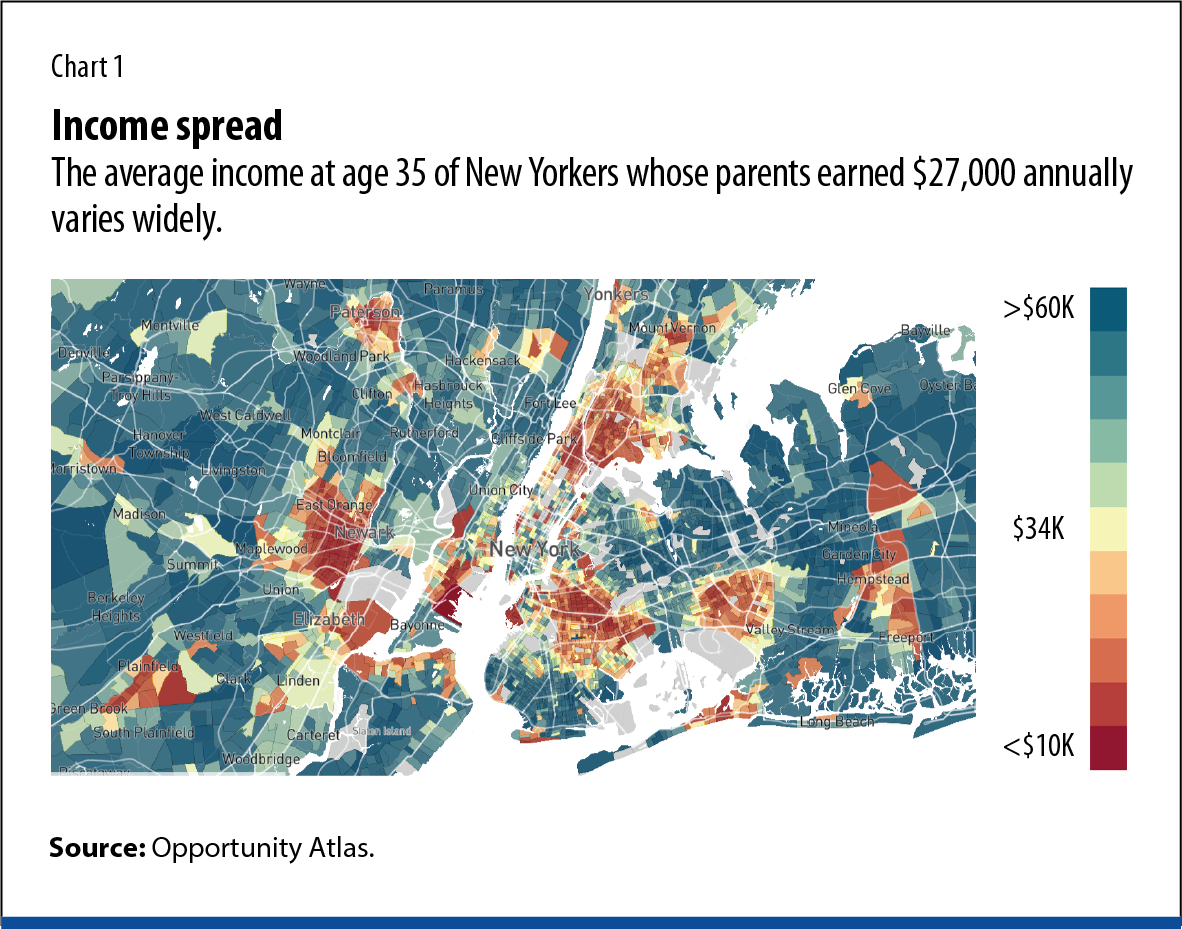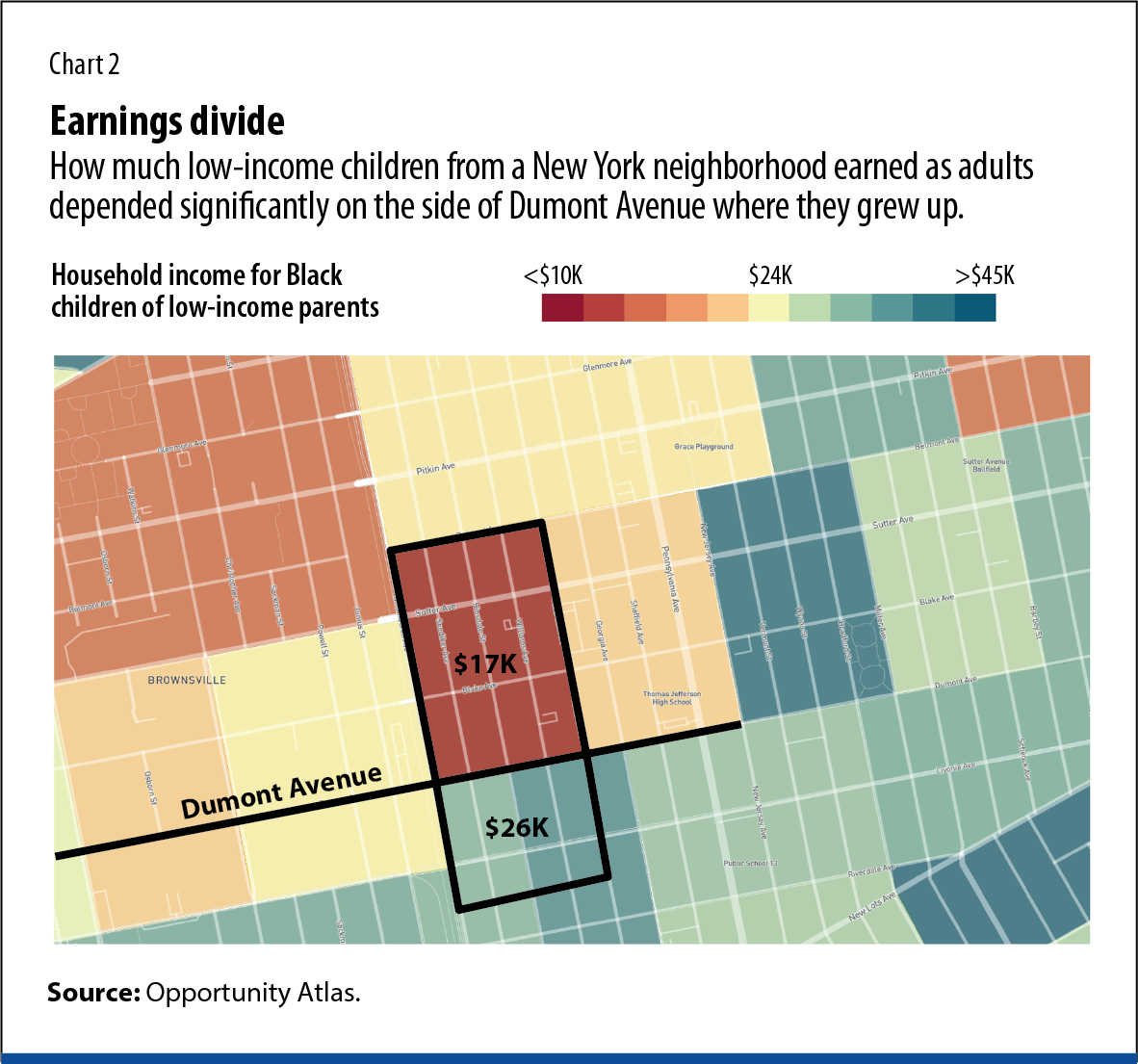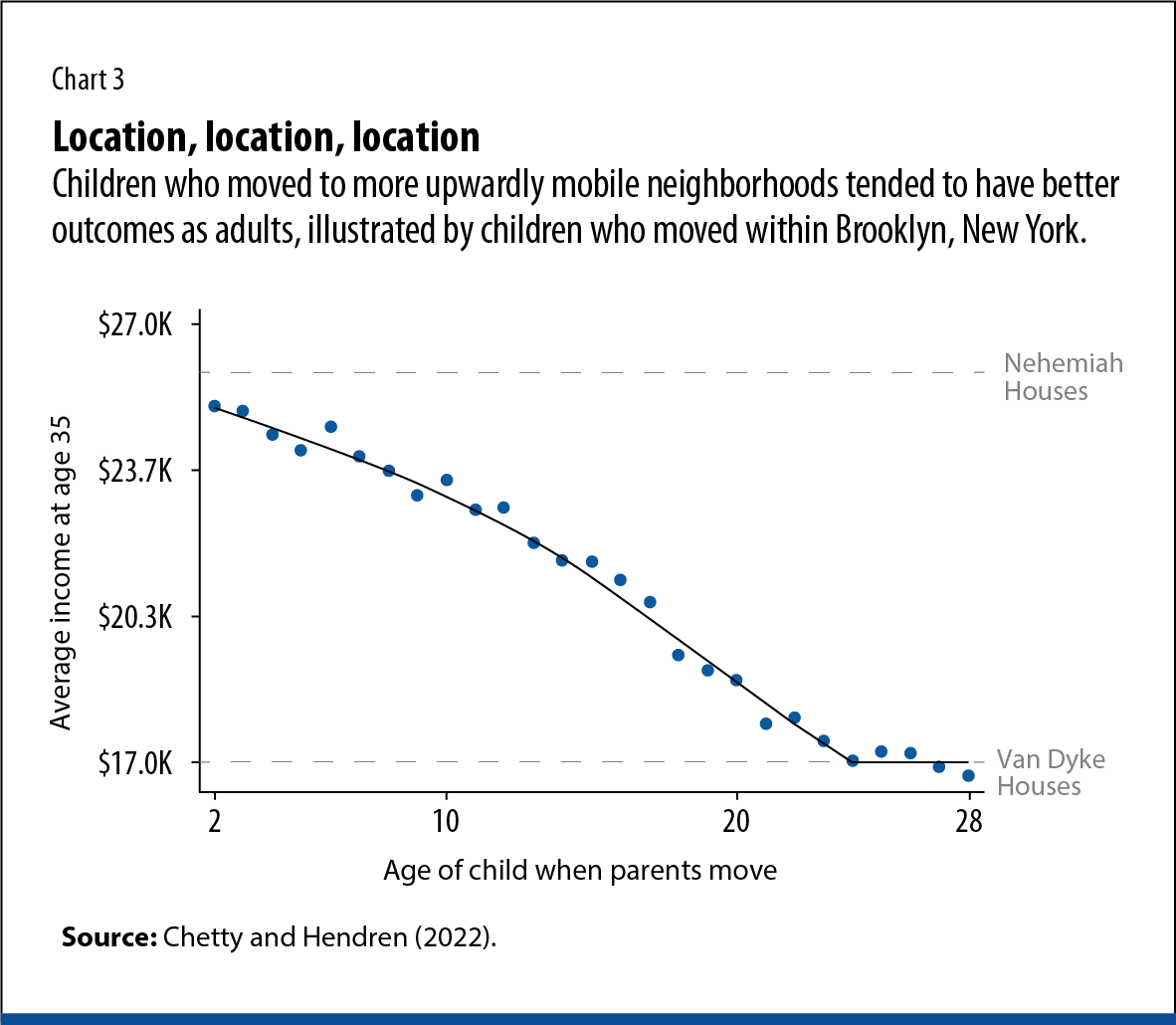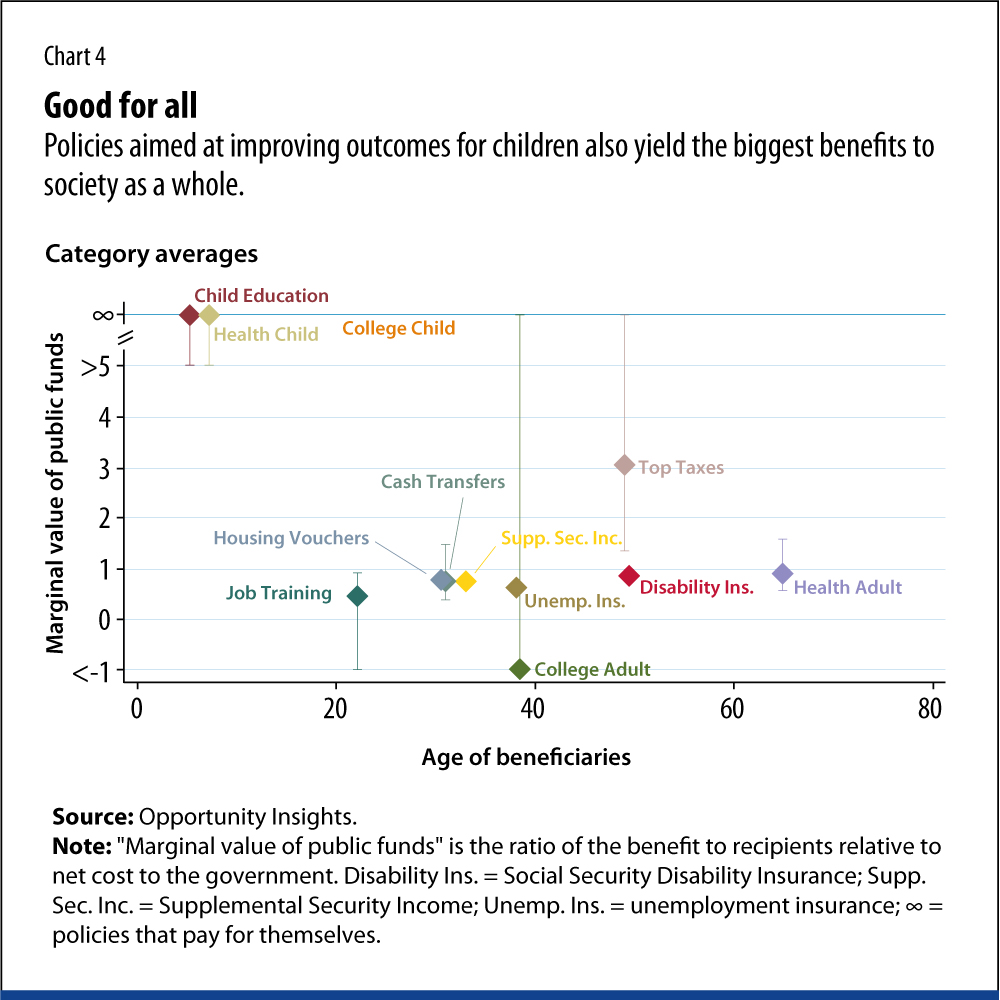Targeting programs during childhood is the best way to increase upward economic mobility
A defining feature of the American Dream is upward mobility—the ability of all children to have a chance at economic success, no matter their background. Unfortunately, children’s chances of earning more than their parents have declined in recent decades. Whereas 90 percent of children born in 1940 grew up to earn more than their parents, only half of today’s young adults earn more than their parents did at the same age. Our research group focuses on understanding which policies can help expand economic opportunity—both in the United States and elsewhere.
The key lesson from our work to date is the importance of targeting policy interventions during childhood. Childhood matters for two reasons. First, children’s environment growing up profoundly shapes their outcomes in adulthood. Second, policies that directly expand investment in children—especially low-income children—are often the most cost-effective way to reduce intergenerational inequality.
The launch point for our analysis is the source material in the Opportunity Atlas, an interactive data set we developed that uses census and tax records to measure upward mobility for every neighborhood in the United States. Using the Opportunity Atlas, we can see that in some neighborhoods low-income children are highly upwardly mobile, while in others, children from comparable backgrounds tend to remain trapped in poverty across generations. For example, Chart 1 shows the wide range of average adult incomes for low-income children growing up across New York City. Chart 2 shows that the income in adulthood of low-income children in the Brownsville neighborhood in Brooklyn depended significantly on which side of Dumont Avenue they grew up.
To better understand how neighborhoods shape children’s outcomes, we studied the life trajectories of more than 5 million children whose families moved while they were growing up. Our main finding is that children who moved to more upwardly mobile neighborhoods—those with higher-quality schools, for instance—tended to have better outcomes as adults. In other words, neighborhoods have substantial causal effects on a child’s outcome as an adult.
Chart 3 illustrates the estimated income gain for hypothetical children who move from the Van Dyke Houses north of Dumont Avenue in Brownsville to the nearby Nehemiah Houses in a rebuilt area just south of Dumont. We predict that children who make this move at age two will earn roughly $25,000 a year as adults, compared with $17,000 a year, on average, had they remained in the Van Dyke Houses. This gain is lower the older children are when they move. Each additional year children spend in a higher-opportunity neighborhood improves how they fare later in life.
Importantly, improvements in environment matter into adolescence and beyond; moving to a better neighborhood at 15 instead of 20 is still quite valuable. It is only after age 23 that there are no longer observable effects on income from a move to a higher-opportunity neighborhood. Similar patterns are observed using experimental evidence covering families randomly assigned to move from high- to low-poverty neighborhoods. In short, childhood neighborhoods shape economic outcomes in adulthood.
The second key aspect of our analysis is determining which types of policies most improve economic opportunity and societal well-being. To find out, we studied 133 policies implemented over the past 50 years. We compared each policy using a standardized metric called the marginal value of public funds (MVPF). A policy’s MVPF is the ratio of the benefit it provides its recipients relative to its net cost to the government—including long-term effects on the budget, such as reduced social expenditures or increased tax revenue. This metric allows us to compare the effectiveness of different types of policies—such as social insurance, taxes, cash transfers, education, job training, and in-kind transfers—to determine which have had the greatest effect on social well-being per dollar of net government spending.
Chart 4 illustrates our main result. We divide the set of 133 policies into 12 programmatic categories and, for each category, plot the average MVPF against the average age of the policies’ beneficiaries. The three points in the upper left reveal that investments in children have historically yielded the highest MVPFs. These policies included expanded health insurance for children, investments in preschool and K–12 education, and policies to increase college attendance.
The pattern in Chart 4 displays a striking similarity to that in Chart 3. In both cases, we find high returns to improving conditions throughout childhood. Each year of exposure to a more upwardly mobile neighborhood improves upward mobility. Likewise, not only do public investments that target young children in preschool yield high returns, but programs aimed at helping older, high-school, and college-age children tend to offer large payoffs to taxpayers as well.
In many cases, we find that these policies end up paying for themselves, saving taxpayers money in the long run. We assign such policies an MVPF of infinity, as illustrated by the three category averages plotted along the top of Chart 4. For example, policies that expanded health care insurance coverage for children, on average yielded $1.80 for every $1.00 in up-front spending. Historically, many policies that expand intergenerational economic opportunity have also benefited taxpayers.
In addition to analyzing historical policies, our research group seeks to use big data to help tailor the next generation of policies to improving economic mobility. A core motivation is the stark geographic variation in mobility revealed by the Opportunity Atlas. The dramatic differences in outcomes depending on where children grow up raise the question of why more families with children don’t move to more upwardly mobile neighborhoods. Surprisingly, we find that even low-income families receiving housing choice vouchers that subsidize rental costs tend to concentrate in neighborhoods characterized by low levels of upward mobility, suggesting that the effect of housing vouchers on reducing residential segregation and expanding economic opportunity has been limited.
To explore why, we developed and tested a program in 2018 in the Seattle Metropolitan Area in collaboration with the Seattle and King County Housing Authority, called Creating Moves to Opportunity (CMTO). To test whether there were barriers preventing voucher recipients from moving to higher-opportunity neighborhoods, we provided a randomly selected group of voucher recipients with a set of services that included housing search assistance, connections to landlords, and financial support. A striking 53 percent of the families receiving assistance moved to higher-opportunity neighborhoods, while only 15 percent of families with no help found housing in high-upward-mobility neighborhoods.
These findings reveal the degree to which barriers (as opposed to preferences) currently limit the ability of low-income families to secure housing in high-opportunity neighborhoods. Reducing such barriers can increase opportunity for children in low-income families. We estimate that children who move at birth to a high-opportunity neighborhood as part of the CMTO program and stay there until adulthood will have lifetime earnings that are $200,000 higher than if they remained in a lower-opportunity neighborhood.
This research is cause for optimism. The data may reveal that the United States is falling short in providing children with equal access to opportunity. But we also show that investments that have historically generated significant benefits to children simultaneously pay dividends to society more broadly, which should increase society’s incentive to enhance upward mobility for all. There is tremendous potential to revive intergenerational mobility—in the United States and elsewhere—through a data-driven policy agenda that expands investments in and opportunities for low-income children.
Opinions expressed in articles and other materials are those of the authors; they do not necessarily reflect IMF policy.
References:
Chetty, Raj, and Nathaniel Hendren. 2022. “Replication Data for: The Impacts of Neighborhoods on Intergen-erational Mobility: (I) Childhood Exposure Effects, and (II) County-Level Estimates.” Opportunity Insights, Harvard Dataverse, Cambridge, MA.














